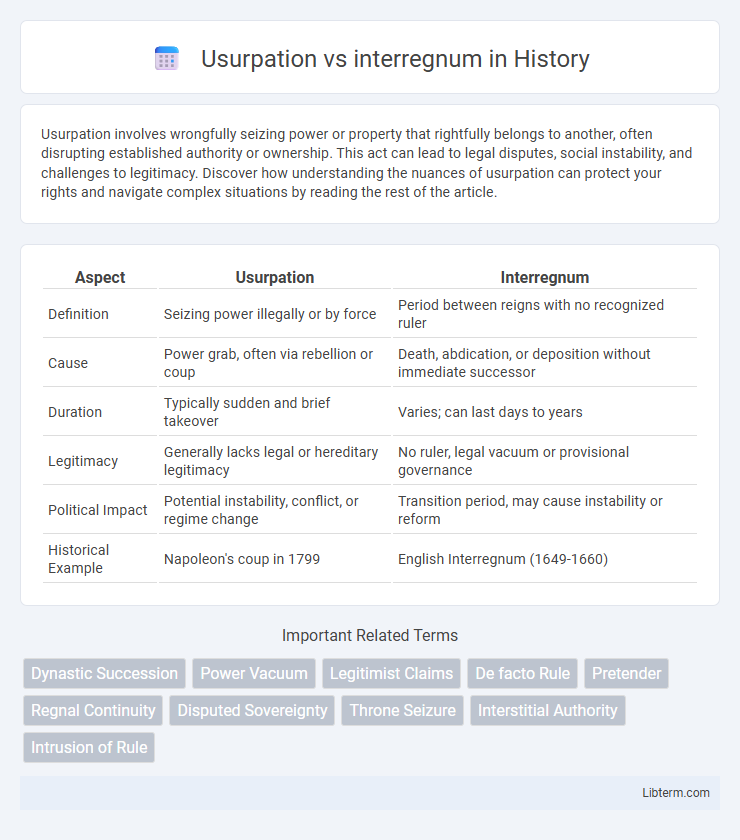Usurpation involves wrongfully seizing power or property that rightfully belongs to another, often disrupting established authority or ownership. This act can lead to legal disputes, social instability, and challenges to legitimacy. Discover how understanding the nuances of usurpation can protect your rights and navigate complex situations by reading the rest of the article.
Table of Comparison
| Aspect | Usurpation | Interregnum |
|---|---|---|
| Definition | Seizing power illegally or by force | Period between reigns with no recognized ruler |
| Cause | Power grab, often via rebellion or coup | Death, abdication, or deposition without immediate successor |
| Duration | Typically sudden and brief takeover | Varies; can last days to years |
| Legitimacy | Generally lacks legal or hereditary legitimacy | No ruler, legal vacuum or provisional governance |
| Political Impact | Potential instability, conflict, or regime change | Transition period, may cause instability or reform |
| Historical Example | Napoleon's coup in 1799 | English Interregnum (1649-1660) |
Understanding Usurpation: Definition and Context
Usurpation refers to the illegal or forceful seizure of power or authority, often bypassing established legal frameworks or rightful succession. It typically involves an individual or group taking control without legitimate claim, disrupting political or organizational stability. Understanding usurpation requires examining its impact on governance structures, legitimacy, and the ensuing conflicts during power struggles.
What is Interregnum? Key Characteristics
Interregnum refers to a period between reigns or governments when normal authority is suspended and no recognized ruler is in place. Key characteristics include a temporary power vacuum, often marked by political instability, absence of formal leadership, and potential conflicts over succession. Unlike usurpation, which involves the unlawful seizure of power, interregnum naturally occurs during transitions such as death or abdication of a monarch without an immediate successor.
Historical Examples of Usurpation
Usurpation involves the unlawful seizure of power, often leading to short-term rule without legitimate succession, as seen in historical cases like Napoleon Bonaparte's ascent during the French Revolution and Richard III's controversial claim to the English throne. Interregnum refers to a period of discontinuity or vacancy in governance, exemplified by England's Interregnum (1649-1660) following the execution of Charles I and preceding the Restoration of the monarchy. Usurpation frequently triggers instability and conflict, whereas interregna mark transitional phases that may reset political order.
Notable Interregnum Periods in History
Notable interregnum periods include the English Interregnum (1649-1660), marked by the abolition of the monarchy and rule under Oliver Cromwell, and the interregnum in the Holy Roman Empire (1254-1273), characterized by the absence of a universally recognized emperor. Unlike usurpation, which involves the illegitimate seizure of power, interregnums signify intentional or uncontrollable gaps in governance often resulting from succession crises or political upheaval. These periods highlight challenges in political stability and succession legitimacy across different historical contexts.
Causes of Usurpation in Political Systems
Usurpation in political systems often stems from power vacuums, weak institutional frameworks, and contested legitimacy of ruling authorities. Ambitious individuals or groups exploit instability, social unrest, or lapses in legal succession to seize control unlawfully. These causes contrast with interregnum periods, which are typically marked by a recognized gap in governance without immediate illegitimate seizure of power.
Factors Leading to Interregnum Situations
Interregnum situations arise primarily due to the absence of a legitimate ruler, often caused by succession disputes, death without an heir, or political instability. Factors like power struggles among nobility, lack of clear succession laws, and external invasions further exacerbate the vacuum of authority during interregnum periods. Unlike usurpation, which involves the seizure of power by an individual, interregnum denotes a temporary power void awaiting lawful governance.
Usurpation vs Interregnum: Core Differences
Usurpation involves the unlawful seizure of power or authority typically by an individual or group, often bypassing established legal or hereditary succession. Interregnum refers to a formal or temporary gap in legitimate governance between successive rulers, usually marked by a lack of sovereign authority but not necessarily illegal action. The core difference lies in usurpation's active, illegitimate claim to power versus interregnum's passive, transitional absence of centralized rule.
Political and Social Impacts
Usurpation often leads to political instability by undermining legitimate authority, triggering power struggles, and provoking public dissent, which can erode trust in governing institutions. Interregnum typically creates a temporary power vacuum that disrupts governance continuity, fosters social uncertainty, and increases the risk of factional conflicts or external interventions. Both scenarios significantly impact social order and political dynamics, influencing the legitimacy and functionality of subsequent regimes.
How Societies Recover from Usurpation or Interregnum
Societies recovering from usurpation often experience rapid power consolidation by new rulers, enabling swift restoration of order through centralized authority and legal reforms. In contrast, recovery from interregnum involves gradual social and political stabilization, frequently requiring negotiated power-sharing and institutional rebuilding to prevent further fragmentation. Both scenarios highlight the critical role of legitimate governance restoration and public trust in reestablishing societal stability.
Contemporary Relevance and Lessons Learned
Usurpation and interregnum both disrupt political order, with usurpation involving unlawful seizure of power and interregnum marking a gap in governance; contemporary relevance is evident in fragile states where power vacuums invite instability. Lessons learned emphasize the necessity of robust legal frameworks and institutional resilience to prevent authoritarian takeovers and ensure smooth transitions during leadership voids. Understanding these concepts aids policymakers in safeguarding democratic processes and maintaining national security amidst political crises.
Usurpation Infographic

 libterm.com
libterm.com